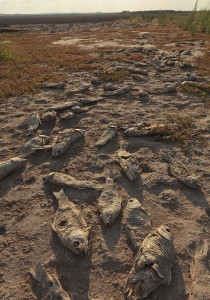Portrait Of A Drought: Finding Water Where It Ain't
 I’m on a bus driving across West Texas and all appears well. Miles and miles of white-speckled cotton fields line both sides of the road. Splotches of green grassland are a welcome sign from last year’s devastating drought. Dozens of giant wind turbines churn away far off in the distance.
I’m on a bus driving across West Texas and all appears well. Miles and miles of white-speckled cotton fields line both sides of the road. Splotches of green grassland are a welcome sign from last year’s devastating drought. Dozens of giant wind turbines churn away far off in the distance.But appearances are deceiving.
West Texas is on the front lines of a changing climate, and scarce water is the most obvious symptom. Everyone – ranchers, farmers, water engineers – is talking about it.
A cyclone of hotter temperatures, more people, water-sapping cotton farming and a devastating 2011 drought have crippled groundwater supplies. And, though the drought has lifted, West Texans are being forced to change their ways like never before.
“It’s quite emotional today,” said Jim Conkwright, general manager of the High Plains Underground Conservation Water District #1, headquartered in Lubbock.
Conkwright is referring to parched conditions across much of the vast Ogallala Aquifer, which have forced first-ever limits on how much water farmers can pump from their wells. This year’s limit is 21 inches per acre per year; in 2014, it drops to 18 inches.
Adding salt to the wound, farmers are being required to install water meters to ensure they don’t exceed their limits. “These are dirty words,” Conkwright said, of the new rules. “This is a very very hot topic. It may result in board members being unseated.”
Farmers aren’t the only ones being affected by the new norm of drier, hotter weather in this historically arid region.
Ranchers at Koch Industries’ Matador Ranch – owned by climate contrarians the Koch Brothers – cut their cattle herd in half and are using a new more resilient grass seed – instead of native grass – on several thousand acres of the 130,000-acre ranch. Ranch managers attribute the changes more to the vicissitudes of changing weather, not to a warming planet.
The City of Lubbock saw one of its key water reservoirs dry up. “Lake Meredith is dead,” said City Engineer Wood Franklin, where customers have been living for many months under Stage Two drought conditions which limit lawn watering to once a week.
The stringent restrictions were lifted in August only after the city activated a new reservoir, Lake Alan Henry, that took several decades to build at a cost of $220 million.
Investors smell opportunity too – in the form of lucrative water rights.
Last year, T. Boone Pickens and his Mesa Water Inc. sold the water rights beneath 211,000 acres – atop the Ogallala Aquifer – for over $100 million to the Canadian River Municipal Water Authority, which serves 11 communities, including Amarillo and Lubbock. Pickens tried selling to Dallas for a higher price, but the $3 billion pipeline was too costly.
“Just as soon as it rained, you couldn’t get ‘em on the phone,” Pickens told the Associated Press, of his negotiations last June with Dallas. “You were always waiting for another drought to start negotiations again.”
The fact that the drought has abated is putting the region’s handling of the water crisis at a crossroads.
Many, like Lubbock’s water engineers, argue for keeping the pedal down on tough water conservation measures. Lubbock’s Water Resources Director Aubrey Spear expressed disappointment that the Stage Two drought restrictions, which helped cut water use by about 25 percent, were lifted so quickly.
“Water conservation is something we’ll want to stress continuously, not just during droughts,” Spear said.
Conkwright expressed similar disappointment that a two-year moratorium is in place for assessing civil penalties against farmers who don’t install water meters and report their water use. “It sends the wrong signal,” he said.
As for West Texas farming in the future, he says, “dry-land farming.”
You can return to the main Market News page, or press the Back button on your browser.

